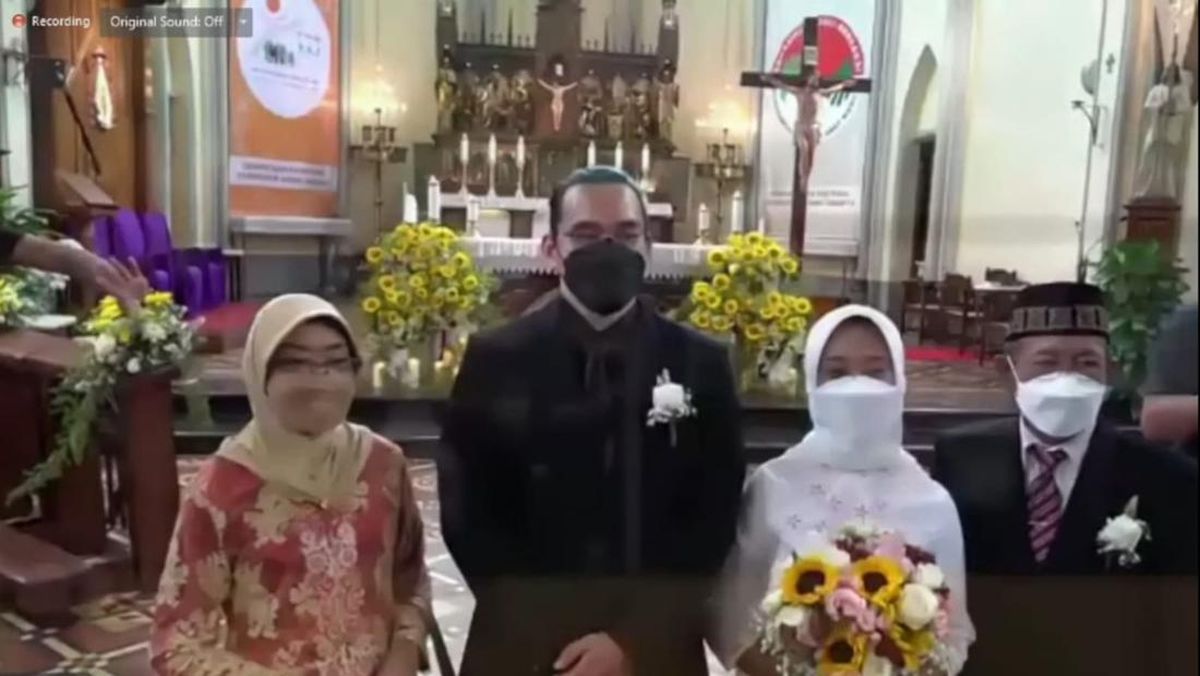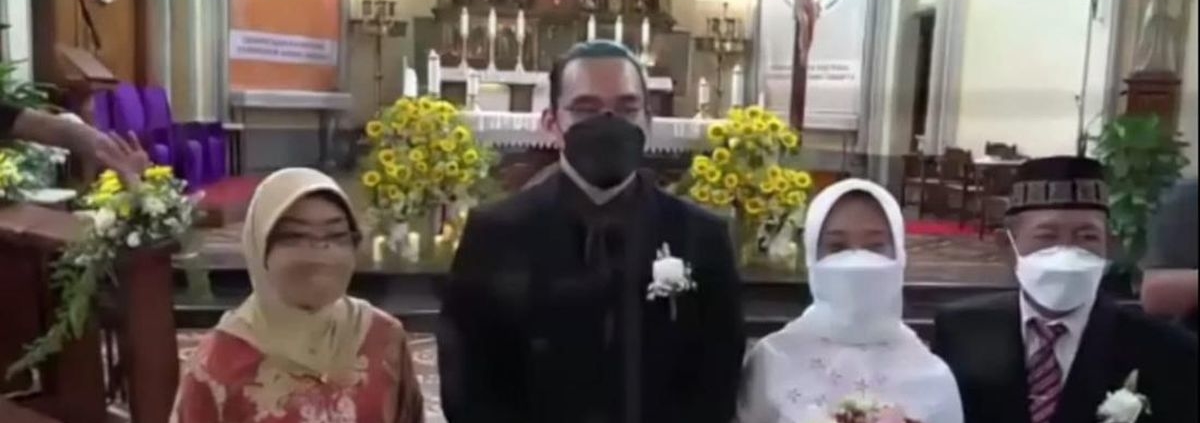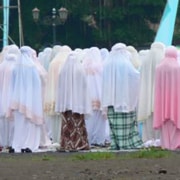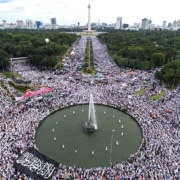
Interreligious marriage is a frequent source of controversy in Indonesia. Screenshot from Ayu Kartika Dewi (YouTube).
In mid-March, one of President Joko Widodo’s female special staffers, Ayu Kartika Dewi, sparked controversy across Indonesia. But it was not because of corruption, abuse of power or any other sort of political scandal. It was simply because Ayu Kartika, a Muslim, married her Catholic boyfriend, Gerald Bastian.
The day after the news emerged, the quasi-state Indonesian Council of Ulama (MUI), which advises the government and society on matters of Islamic law, firmly stressed that interreligious marriage was not allowed under Indonesia’s Marriage Law (No. 1 of 1974). The archbishop of Jakarta, who married the couple, was then forced to publicly defend his decision to officiate at the ceremony.
The case has prompted new reflection on the 1974 Marriage Law – a landmark piece of legislation and arguably one of the most discussed and debated laws in Indonesia. In fact, the law is among the pieces of legislation most frequently challenged in the Constitutional Court. At least 10 cases arguing that provisions of the Marriage Law are unconstitutional have been brought before the court since it was established in 2003.
The question of how religious laws should be interpreted and implemented under the Marriage Law has been a central focus of debate, since even before the Marriage Law was enacted.
In two years, the law will turn 50. Is it time to revise the law? How likely is this to happen?
The law and its history
The Marriage Law is no ordinary piece of legislation. After Indonesia gained independence in 1945, there were multiple failed attempts to establish a national system of family law to unify the diverse laws that regulated marriage in the country. Looking back at the heated drafting process, it is remarkable that the Marriage Law was ever passed at all.
It is also important to remember that while it is often criticised now, the law was viewed as a major improvement for the rights of women in marriage at the time it was passed.
Before the passage of the Marriage Law, marriages were regulated by a patchwork of Dutch, religious and customary law. For example, marriages of Europeans and ethnic Chinese were regulated under the colonial Civil Code (Burgerlijk Wetboek), Christian Indonesians were subject to a Dutch colonial regulation (Huwelijk Ordonnantie Christen Indonesiers, HOCI), the marriages of non-Chinese “foreign Orientals” (Indians and Arabs) were regulated by their respective customary laws, while most Muslim Indonesians were married under a mix of Islamic and customary law. A Dutch colonial regulation (Staatsblad 1898 No. 158) also allowed for mixed marriages.
Indonesian women’s organisations had been pushing for marriage law reform since the early 1900s, arguing for equal rights of women in matters of marriage and divorce. Finally, in 1973, under Soeharto’s New Order, the government initiated a marriage bill and submitted it to the legislature.
Elements of the bill were highly contentious. In the initial draft, the minimum marriageable age was 21 for men and 18 for women, marriages needed to be registered to be considered valid, polygamy and divorce could only take place with court approval, and interreligious marriage was possible.
Islamic organisations expressed vociferous opposition to these proposals, which they viewed as conflicting or interfering with requirements under Islamic law. In the legislature, the Islam-based United Development Party (PPP) opposed the bill, while the government’s political vehicle Golkar, the Indonesian Democratic Party (PDI) and the military faction all backed it.
The government eventually realised that compromises with the Islamic community would have to be made. After tense negotiations, the legislature finally reached an agreement: Islamic law on marriage could not be interfered with or changed; any articles in the proposed bill that could not be adjusted to Islamic law would be dropped; and failure to register a marriage with the state would not make it invalid. The article that allowed for interreligious marriage was dropped completely. The law was enacted in January 1974 after a seven-month process.
The result is that the 1974 Marriage Law states that: marriage is valid if performed according to the laws of each person’s religions and beliefs (Article 2(1)), but every marriage should be registered according to prevailing laws and regulations (Article 2(2)). So, a marriage cannot be valid unless performed according to the rules of a recognised religion, and, while marriages should be registered, failure to do so will not make them invalid.
Some Muslims have interpreted Article 2(1) as prohibiting interfaith marriage, as they note that Islamic teaching does not permit Muslim women to marry non-Muslim men. Indeed, in 2005, the MUI also issued a fatwa (religious opinion) stating that interreligious marriage is prohibited for Muslims. While MUI fatwa are not a source of law and are not legally binding on the Indonesian state or society, they are often very influential.
Although the final Marriage Law was weaker than the original proposal, it did result in several crucial improvements to the rights of women. For example, the law clearly states that a marriage must be based on consent, women are equal to men in terms of their rights and position in marriage, and divorces can only take place with court approval.
Likewise, polygamy is restricted – men must fulfill certain conditions and apply to a court if they wish to take another wife. It is not widely understood, but a polygamous marriage that is not court-approved may constitute a criminal offence. The negotiations also resulted in a minimum marriageable age of 19 for men and 16 for women, but it still allowed child marriage if approved by parents and a court.
The law in action
Changing deeply rooted customary practices related to marriage is challenging. The law has arguably had some success in reducing high rates of polygamy, but its impact on child marriage has been weaker.
However, because the law requires husbands to apply to a court if they wish to take on additional wives, unregistered polygamy is still widespread. In one famous case, dangdut singer Machica Mochtar caused a scandal when she revealed that she had married the already-married former State Secretary Minister Moerdiono in a religious ceremony in 1993.
A major concern with unregistered polygamous marriages is that women and children are poorly protected. Children of polygamous marriages can struggle to obtain legal identity documents, access to education, social welfare and more. Indeed, until 2012, children of unregistered polygamous marriages were only considered to have a civil relationship with their mother and her family. It was not until Machica challenged the Marriage Law in the Constitutional Court that these children were also considered to have a civil relationship with their fathers, if such a relationship could be proven. Meanwhile, women in illegal polygamous marriages are at a high risk of gender-based violence and have no divorce, custody or inheritance rights, because their marriages are not formally registered.
Although most Indonesians have interpreted the 1974 Marriage Law as not allowing interreligious marriage, this issue has not gone away. Indeed, as early as the 1980s, there was a notable case involving a Muslim woman, Andi Vonny Gani Parengi, and Christian man, Adrianus Petrus Hendrik, who applied to have their interfaith marriage registered by the religious affairs and civil registry offices. When both refused, the Supreme Court ruled there was nothing in the 1974 Marriage Law that prevented interreligious marriage and the civil registry should register the marriage. At the time, the Supreme Court urged the government to resolve this “legal vacuum”, but very little has been done.
In another landmark case in 2014, a group of Universitas Indonesia students attempted to challenge Article 2(1) of the Marriage Law at the Constitutional Court to clearly allow interreligious marriage. But they were unsuccessful.
On the issue of child marriage, in 2019, the Constitutional Court made the surprising decision that the minimum marriageable age of 16 years for women was unconstitutional. The court ruled that the legislature (DPR) must revise the Marriage Law within three years so that it the marriageable age was equal for both men and women. The DPR followed up later that year, setting the minimum age at 19 for men and women. This legal change alone will not be enough to eliminate underage marriage, which is driven by multiple factors. But it was a major and welcome reform.
What’s next?
Looking back at the convoluted and heated drafting process that led to the passage of the 1974 Marriage Law, and the way it has been interpreted and discussed ever since, the prospects for a careful and comprehensive debate on its revision look very limited indeed. The law touches on a highly sensitive but common practice involving all religions in Indonesia and, indeed, all citizens, in one way or another. It would take a tremendous effort to achieve the consensus needed to amend it.
On more than one occasion, a Constitutional Court decision has been powerful enough to result in a different interpretation of the law or lead to its amendment, for example in relation to child marriage. Encouragingly, the Supreme Court followed up the decision on child marriage by issuing guidelines (Perma No. 5 of 2019) for judges on adjudicating applications for permission to marry underage. The guidelines have a strong emphasis on child protection, stipulating that judges must examine the reasons for marriage, ensure that there is no coercion involved, hear from the children without their parents present, and remind all present about the risks involved (relating to discontinuation of education and teenage pregnancy). If permission is granted, parents must commit to continue to support their children’s finances, health, education and social affairs.
As Indonesian society keeps changing, its laws must also keep up. Given the highly contentious nature of the 1974 Marriage Law, the Constitutional Court may be the only hope for future reform.
Ayu Kartika and Gerald may have been married in a religious ceremony, but it is not clear whether they will be able to register that marriage. It is clear, however, that they will not be the last interfaith couple who want their marriage acknowledged by the state.











